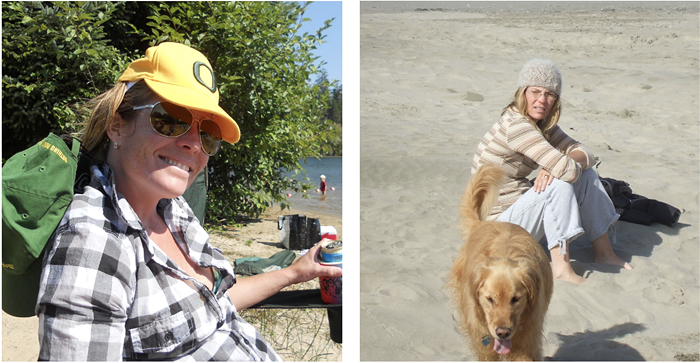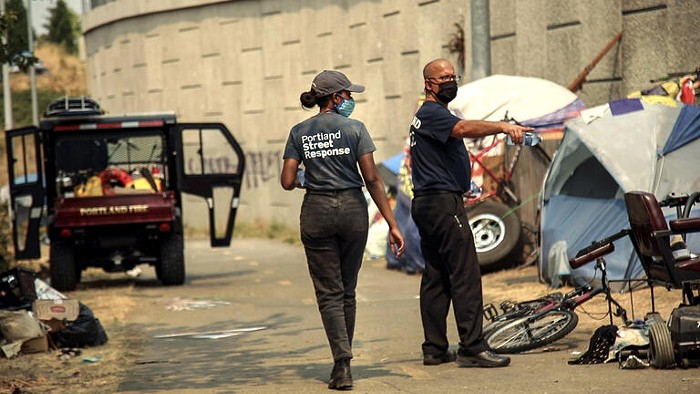WHEN A HOMELESS man was shot by police on the Springwater Corridor this month ["Before the Crowbar," News, June 18], it followed advocates' protestations about city crackdowns on campsites along the popular recreational trail.
And Nicholas Glendon Davis' death spurred breathless TV news reports about transients living on the Springwater—accounts that tapped into neighbors' ample angst.
But the biggest recent news in the Springwater's ongoing issues with homelessness might have come in May, just west of where Davis was killed. There and in three other places, mint-green portable toilets have quietly popped up along the trail, which beats a meandering path east from the Willamette River to the little town of Boring.
"Their installation came from direction from Parks Commissioner Amanda Fritz's office," says Portland Parks and Recreation spokesman Mark Ross, "following discussions about homeless issues."
Mayor Charlie Hales' office has directed much of its attention around homelessness toward cleanups and enforcement, while calling for millions in new funding for services ["Sweeping Up," News, April 9]. Fritz, meanwhile, has been taking a different approach.
As reported by the Mercury, lately she's been talking not so much about getting illegal campers off of public space. Instead, she's trying to figure out whether people in dire life circumstances might be allowed to sleep on city land—provided they're not causing trouble ["The Neutral Zone," News, June 11].
The toilets, say city staffers and advocates for the homeless, are part of that question.
"Amanda understands that in order to get to the bottom of this problem, we have to do some harm reduction," says Israel Bayer, executive director of Street Roots. "You can sweep people and cry until you're blue in the face about homeless people on the Springwater. The reality is that people are going to live on the Springwater."
The four toilets are spaced at regular intervals between the Willamette and SE 174th. The most used, according to the parks bureau, is a commode at SE 100th. It's near a section of the trail that, on a recent visit, was dotted with visible campsites. It's also roughly four blocks west of where Portland Police Officer Robert Brown shot Davis, a homeless man who police say had come at officers with a crowbar.
Fritz declined to discuss her rationale for the toilets at length.
Portable toilets "are for everyone to use," she wrote in a text message. "Both people living inside and people living outside need a decent place to go to the bathroom while on the Springwater."
But the commissioner has been more forceful recently, posing questions about campsite enforcement that have been rarely heard in Portland City Hall.
"Are there situations where, if people were on city property, other than sidewalks, and if they weren't causing a problem," she told the Mercury while discussing homeless camping downtown, "that we would not be moving them on until morning?"
If the restrooms are an olive branch of sorts, they come as advocates for the homeless complain the city's been cracking down harder than usual on Springwater campers.
In mid-May, not long after the first portable toilets were installed, the parks bureau ousted campers along a five-mile stretch of trail in order to remove invasive plants.
The bureau says it gave ample notice, but advocates with East Portland's Clackamas Service Center claim city workers callously pushed campers along, and left chopped bushes and shrubs on their remaining property (the parks bureau says that the only objects left at the campsites were refuse). More recently, Trena Sutton, a longtime advocate, says the campers who've tried returning to the trimmed areas have developed skin rashes—which the Clackamas Service Center has called in a nurse to examine.
"People are coming up with serious skin conditions that have been in the brush since then, trying to find a place to sleep," Sutton says.
Ross, with the parks bureau, says workers sprayed herbicide in the area, but that it shouldn't have been a problem once dry. He notes poison oak also is prevalent on the Springwater.
Through June 18, park rangers had formally excluded 23 people from the Springwater this year, mostly for camping, Ross says. They'd issued 18 warnings for camping, made 50 referrals to homeless outreach organization JOIN, and called police and Multnomah County Animal Services on "a handful" of camps.
"One such camp was contacted multiple times and resulted in rangers issuing five warnings for off-leash dogs and one citation," Ross wrote in an email.
Still, he says, the majority of the bureau's contacts with people along the trail are "positive."
Parks isn't the only bureau breaking up camping on the Springwater. The Bureau of Environmental Services (BES) oversees swaths of land along the corridor. The bureau called out city contractor Pacific Patrol Services to clean up sites twice in May, and has another cleanup scheduled for Thursday, June 26, according to Eli Callison, a program specialist who oversees the cleanups for the bureau.
Callison's grappled with homeless camps on the Springwater for years. He's used to kicking campers out of one area, only to find them on BES property farther down the trail. And this year, he thinks there are more campsites off the Springwater than in the past.
"It's kind of moving around in a circle," he says. "It's not solving the solution for why they're out there homeless. It's putting a Band-Aid on the problem where they're at."



















